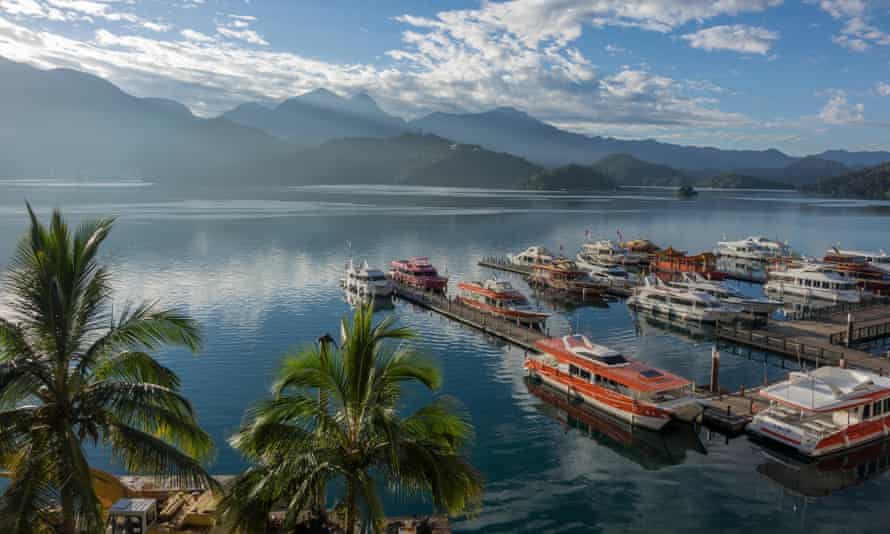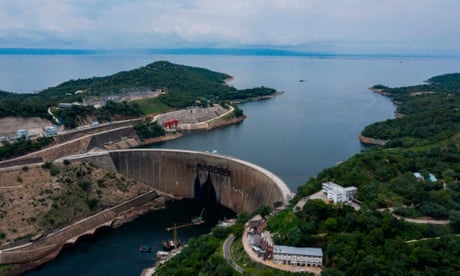Taiwan’s Sun Moon Lake is so low that parts of it have dried and turned to grass. Jetties that normally float are sprawled awkwardly on dry land, and tour boats are crowded at the tail ends of pontoons still in the water.
Usually one of the island’s most famous tourist destinations, the lake has recently become a star of a different kind. Following the worst drought in 56 years, it is now famous for all the wrong reasons. These days, Instagram influencers photograph themselves posing in a dust-coloured, dinghy half-buried in a cracked and cratered lakebed.
Earlier this month, the resurfacing of a long-lost mobile phone (which still worked) made international news, while China’s hawkish tabloid, the Global Times, seized on the discovery of a suspected Qing dynasty tombstone to bolster the mainland’s claims of sovereignty over Taiwan.
But away from the quirky headlines, the situation is dire. Other reservoirs across central and southern Taiwan are effectively empty, down to 5% or less. Last week, there were reports of mass fish deaths, a phenomenon seen in Australia’s drought.
Taiwan has had drought before but observers are hoping the severity of this one – which has lasted 18 months, and threatens Taiwan’s economic lifeblood of semiconductor production – is enough to prompt real action on climate change.
Taiwan relies heavily on seasonal typhoons to top up reservoirs, but in 2020 not one made landfall. And it could happen again.
Dr Huang-Hsiung Hsu, executive officer at Academica Sinica’s anthropogenic climate change centre, says studies have suggested “fewer but stronger typhoons, drier springs, fewer rainy days, and stronger precipitation strength in the warming future, in addition to the expected significant temperature rise and heatwaves as everywhere around the world”.
“[This will] mean a higher risk of water shortage and natural disasters such as flooding and landslide.”
He said governments have not been sincere in their commitment to climate crisis policy, and he joined other observers who say the government is not prepared for the future.
There are plans to redirect rivers and raise reservoirs, but in response to the current crisis authorities have closed swimming pools, saunas and carwashes, ordered companies to cut water use, and some counties, including Taichung on the west coast, are preparing to redig decades-old wells.
There have been mass prayer events to the god Matsu, and government scientists have conducted what Hsu calls the “immature technology” of cloud seeding. Many people across the island are under tight restrictions, with tap water shut off for entire areas for two days a week.
Every Wednesday afternoon, Dino Chang fills every available container in the house with water, including a baby bath in the corner of her bathroom. Chang even saves the water from the dehumidifier.
In her kitchen, the 43-year-old carefully separates water for washing and the water for cooking, although during their two waterless days, she and her husband tend to get UberEats. They also shower as late as possible.
If she calculates correctly, their stored water will last until the supply comes back on. If not, she’ll have to carry a bucket two blocks through her middle-class Taichung neighbourhood to a temporary emergency tank, which bears the sign: “Treasure the water sources, this is for living. If you steal it, there will be consequences.”
Observers say few of the measures taken so far address the long-term prospect that Taiwan might not be able to rely on typhoons in the future, and the official attitude avoids a core issue: the population pays too little for water while using too much of it.
Residents are estimated to have some of the cheapest water in the world, and in 2020 used an average of 289 litres every day. Those in the capital, Taipei, used an average of 338 litres. This compares to 142 litres a day in the UK.

Population and power is centred in Taipei, which gets its water from a clean and plentiful reservoir and rarely suffers such shortages.
With such low pricing, it’s hard to remember what’s going on elsewhere, unless you’re having to fill buckets every Wednesday. “People have no incentive to conserve, recycle or come up with innovative solutions,” says Thomas Liou, associate professor with Feng Chia University’s urban planning department.
He says governments have long known that raising the price of water is electoral suicide. “Unless you have a crisis,” he adds, noting small increases after the 1999 earthquake. “This year might be the time to try.”
Chang and her friends don’t want the price to rise but concede it probably should. Lai Yen-tso, 32, says leakage – 16.8% in Taichung – is a bigger issue than Taiwan’s liberal use of the tap. Rika Tseng, 37, says if an election candidate actually ran on a platform of higher water prices, she’d vote for them just for their bravery.
The ministry for economic affairs – one of three departments with water responsibilities – conceded that the price was low, and said the government bore much of the cost, but that the price was determined by a “complicated” legal process involving multiple departments.
“In principle, we should take care of the basic needs of the people and expand the difference in water charges to encourage major water users to conserve more.”
One of those major users – manufacturing giant TSMC – uses about 156 million litres a day. The company makes a large percentage of the world’s semiconductors (used in electronics ranging from cars to phones), and contributes 4% of GDP. The drought has prompted international concern about supplies.
TSMC isn’t subject to the two-day shutdowns but companies have been told to cut usage by 15%. It is trucking in water to some places, and in recent years has increased its conservation and recycling processes.
“TSMC has a long-established risk management system, which covers water supply risk,” chief executive CC Wei told a conference earlier this month.
“Through our existing water-conservation measures, we are able to meet the current reduction requirement from the government with no impact on operations.”

Sitting around a dining table, the Taichung friends manage to laugh a little about their plight. They’ve refined their water storing since rushing out to panic-buy containers four weeks ago, and Chang and Lai say they’re getting used to it.
But Tseng, whose home and workplace are on opposite sides of the Taichung divide, giving her four days a week of shutdowns to deal with, is over it.
“When you face water shortages, you treasure the water,” she says. “When you don’t have it, you’re always thinking about the times you did.”
On Thursday, rain arrived at Sun Moon Lake. Though 24 hours of drizzle wasn’t enough to break the drought, at least there was some rain.
“Taiwan is not a country without water,” says Liou. “We just don’t have good ways to retain and distribute it.”
